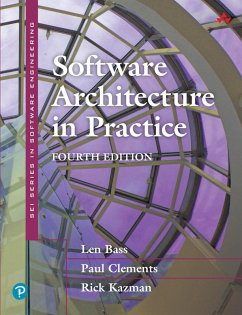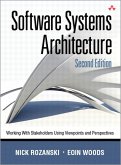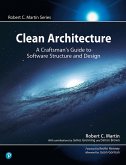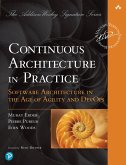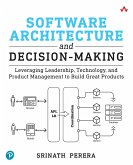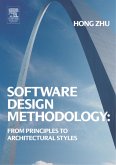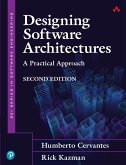

Alle Infos zum eBook verschenken

- Format: PDF
- Merkliste
- Auf die Merkliste
- Bewerten Bewerten
- Teilen
- Produkt teilen
- Produkterinnerung
- Produkterinnerung

Hier können Sie sich einloggen

Bitte loggen Sie sich zunächst in Ihr Kundenkonto ein oder registrieren Sie sich bei bücher.de, um das eBook-Abo tolino select nutzen zu können.
The Definitive, Practical, Proven Guide to Architecting Modern Software--Fully Updated with New Content on Mobility, the Cloud, Energy Management, DevOps, Quantum Computing, and More Updated with eleven new chapters, Software Architecture in Practice, Fourth Edition, thoroughly explains what software architecture is, why it's important, and how to design, instantiate, analyze, evolve, and manage it in disciplined and effective ways. Three renowned software architects cover the entire lifecycle, presenting practical guidance, expert methods, and tested models for use in any project, no matter…mehr
- Geräte: PC
- ohne Kopierschutz
- eBook Hilfe
- Größe: 6.18MB
![Software Systems Architecture (eBook, PDF) Software Systems Architecture (eBook, PDF)]() Nick RozanskiSoftware Systems Architecture (eBook, PDF)43,95 €
Nick RozanskiSoftware Systems Architecture (eBook, PDF)43,95 €![Clean Architecture (eBook, PDF) Clean Architecture (eBook, PDF)]() Robert C. MartinClean Architecture (eBook, PDF)22,95 €
Robert C. MartinClean Architecture (eBook, PDF)22,95 €![Continuous Architecture in Practice (eBook, PDF) Continuous Architecture in Practice (eBook, PDF)]() Murat ErderContinuous Architecture in Practice (eBook, PDF)19,95 €
Murat ErderContinuous Architecture in Practice (eBook, PDF)19,95 €![Software Architecture and Decision-Making (eBook, PDF) Software Architecture and Decision-Making (eBook, PDF)]() Srinath PereraSoftware Architecture and Decision-Making (eBook, PDF)20,95 €
Srinath PereraSoftware Architecture and Decision-Making (eBook, PDF)20,95 €![Software Design Methodology (eBook, PDF) Software Design Methodology (eBook, PDF)]() Hong ZhuSoftware Design Methodology (eBook, PDF)41,95 €
Hong ZhuSoftware Design Methodology (eBook, PDF)41,95 €![Designing Software Architectures (eBook, PDF) Designing Software Architectures (eBook, PDF)]() Humberto CervantesDesigning Software Architectures (eBook, PDF)34,95 €
Humberto CervantesDesigning Software Architectures (eBook, PDF)34,95 €![The Mythical Man-Month, Anniversary Edition (eBook, PDF) The Mythical Man-Month, Anniversary Edition (eBook, PDF)]() Frederick P. BrooksThe Mythical Man-Month, Anniversary Edition (eBook, PDF)25,95 €
Frederick P. BrooksThe Mythical Man-Month, Anniversary Edition (eBook, PDF)25,95 €-
-
-
- Discover how architecture influences (and is influenced by) technical environments, project lifecycles, business profiles, and your own practices
- Leverage proven patterns, interfaces, and practices for optimizing quality through architecture
- Architect for mobility, the cloud, machine learning, and quantum computing
- Design for increasingly crucial attributes such as energy efficiency and safety
- Scale systems by discovering architecturally significant influences, using DevOps and deployment pipelines, and managing architecture debt
- Understand architecture's role in the organization, so you can deliver more value
Dieser Download kann aus rechtlichen Gründen nur mit Rechnungsadresse in A, B, BG, CY, CZ, D, DK, EW, E, FIN, F, GR, HR, H, IRL, I, LT, L, LR, M, NL, PL, P, R, S, SLO, SK ausgeliefert werden.
Hinweis: Dieser Artikel kann nur an eine deutsche Lieferadresse ausgeliefert werden.
- Produktdetails
- Verlag: Pearson ITP
- Seitenzahl: 464
- Altersempfehlung: ab 18 Jahre
- Erscheinungstermin: 30. Juni 2021
- Englisch
- ISBN-13: 9780136885672
- Artikelnr.: 63708695
- Verlag: Pearson ITP
- Seitenzahl: 464
- Altersempfehlung: ab 18 Jahre
- Erscheinungstermin: 30. Juni 2021
- Englisch
- ISBN-13: 9780136885672
- Artikelnr.: 63708695
- Herstellerkennzeichnung Die Herstellerinformationen sind derzeit nicht verfügbar.
Dr. Paul Clements, VP of Customer Success with BigLever Software, helps organizations gain value from Product Line Engineering (PLE). As senior member of technical staff at SEI, he led advanced projects in PLE and software architecture.
Rick Kazman is Professor, University of Hawaii, and Visiting Researcher at SEI. His interests include software architecture, visualization, design, analysis, and economics. He co-created influential architecture analysis methods and tools, including SAAM, ATAM, CBAM, Dali, and Titan.
Acknowledgments xvii
Part I: Introduction 1
Chapter 1: What Is Software Architecture? 1
1.1 What Software Architecture Is and What It Isn't 2
1.2 Architectural Structures and Views 5
1.3 What Makes a "Good" Architecture? 19
1.4 Summary 21
1.5 For Further Reading 21
1.6 Discussion Questions 22
Chapter 2: Why Is Software Architecture Important? 25
2.1 Inhibiting or Enabling a System's Quality Attributes 26
2.2 Reasoning about and Managing Change 27
2.3 Predicting System Qualities 28
2.4 Communication among Stakeholders 28
2.5 Early Design Decisions 31
2.6 Constraints on Implementation 31
2.7 Influences on Organizational Structure 32
2.8 Enabling Incremental Development 33
2.9 Cost and Schedule Estimates 33
2.10 Transferable, Reusable Model 34
2.11 Architecture Allows Incorporation of Independently Developed Elements
34
2.12 Restricting the Vocabulary of Design Alternatives 35
2.13 A Basis for Training 36
2.14 Summary 36
2.15 For Further Reading 37
2.16 Discussion Questions 37
Part II: Quality Attributes 39
Chapter 3: Understanding Quality Attributes 39
3.1 Functionality 40
3.2 Quality Attribute Considerations 41
3.3 Specifying Quality Attribute Requirements: Quality Attribute Scenarios
42
3.4 Achieving Quality Attributes through Architectural Patterns and Tactics
45
3.5 Designing with Tactics 46
3.6 Analyzing Quality Attribute Design Decisions: Tactics-Based
Questionnaires 48
3.7 Summary 49
3.8 For Further Reading 49
3.9 Discussion Questions 50
Chapter 4: Availability 51
4.1 Availability General Scenario 53
4.2 Tactics for Availability 55
4.3 Tactics-Based Questionnaire for Availability 62
4.4 Patterns for Availability 66
4.5 For Further Reading 68
4.6 Discussion Questions 69
Chapter 5: Deployability 71
5.1 Continuous Deployment 72
5.2 Deployability 75
5.3 Deployability General Scenario 76
5.4 Tactics for Deployability 78
5.5 Tactics-Based Questionnaire for Deployability 80
5.6 Patterns for Deployability 81
5.7 For Further Reading 87
5.8 Discussion Questions 87
Chapter 6: Energy Efficiency 89
6.1 Energy Efficiency General Scenario 90
6.2 Tactics for Energy Efficiency 92
6.3 Tactics-Based Questionnaire for Energy Efficiency 95
6.4 Patterns 97
6.5 For Further Reading 98
6.6 Discussion Questions 99
Chapter 7: Integrability 101
7.1 Evaluating the Integrability of an Architecture 102
7.2 General Scenario for Integrability 104
7.3 Integrability Tactics 105
7.4 Tactics-Based Questionnaire for Integrability 110
7.5 Patterns 112
7.6 For Further Reading 114
7.7 Discussion Questions 115
Chapter 8: Modifiability 117
8.1 Modifiability General Scenario 120
8.2 Tactics for Modifiability 121
8.3 Tactics-Based Questionnaire for Modifiability 125
8.4 Patterns 126
8.5 For Further Reading 130
8.6 Discussion Questions 131
Chapter 9: Performance 133
9.1 Performance General Scenario 134
9.2 Tactics for Performance 137
9.3 Tactics-Based Questionnaire for Performance 145
9.4 Patterns for Performance 146
9.5 For Further Reading 149
9.6 Discussion Questions 150
Chapter 10: Safety 151
10.1 Safety General Scenario 154
10.2 Tactics for Safety 156
10.3 Tactics-Based Questionnaire for Safety 160
10.4 Patterns for Safety 163
10.5 For Further Reading 165
10.6 Discussion Questions 166
Chapter 11: Security 169
11.1 Security General Scenario 170
11.2 Tactics for Security 172
11.3 Tactics-Based Questionnaire for Security 176
11.4 Patterns for Security 179
11.5 For Further Reading 180
11.6 Discussion Questions 180
Chapter 12: Testability 183
12.1 Testability General Scenario 186
12.2 Tactics for Testability 187
12.3 Tactics-Based Questionnaire for Testability 192
12.4 Patterns for Testability 192
12.5 For Further Reading 194
12.6 Discussion Questions 195
Chapter 13: Usability 197
13.1 Usability General Scenario 198
13.2 Tactics for Usability 200
13.3 Tactics-Based Questionnaire for Usability 202
13.4 Patterns for Usability 203
13.5 For Further Reading 205
13.6 Discussion Questions 205
Chapter 14: Working with Other Quality Attributes 207
14.1 Other Kinds of Quality Attributes 207
14.2 Using Standard Lists of Quality Attributes--Or Not 209
14.3 Dealing with "X-Ability": Bringing a New QA into the Fold 212
14.4 For Further Reading 215
14.5 Discussion Questions 215
Part III: Architectural Solutions 217
Chapter 15: Software Interfaces 217
15.1 Interface Concepts 218
15.2 Designing an Interface 222
15.3 Documenting the Interface 228
15.4 Summary 230
15.5 For Further Reading 230
15.6 Discussion Questions 231
Chapter 16: Virtualization 233
16.1 Shared Resources 234
16.2 Virtual Machines 235
16.3 VM Images 238
16.4 Containers 239
16.5 Containers and VMs 241
16.6 Container Portability 242
16.7 Pods 242
16.8 Serverless Architecture 243
16.9 Summary 244
16.10 For Further Reading 245
16.11 Discussion Questions 245
Chapter 17: The Cloud and Distributed Computing 247
17.1 Cloud Basics 248
17.2 Failure in the Cloud 251
17.3 Using Multiple Instances to Improve Performance and Availability 253
17.4 Summary 261
17.5 For Further Reading 262
17.6 Discussion Questions 262
Chapter 18: Mobile Systems 263
18.1 Energy 264
18.2 Network Connectivity 266
18.3 Sensors and Actuators 267
18.4 Resources 268
18.5 Life Cycle 270
18.6 Summary 273
18.7 For Further Reading 274
18.8 Discussion Questions 275
Part IV: Scalable Architecture Practices 277
Chapter 19: Architecturally Significant Requirements 277
19.1 Gathering ASRs from Requirements Documents 278
19.2 Gathering ASRs by Interviewing Stakeholders 279
19.3 Gathering ASRs by Understanding the Business Goals 282
19.4 Capturing ASRs in a Utility Tree 284
19.5 Change Happens 286
19.6 Summary 286
19.7 For Further Reading 287
19.8 Discussion Questions 287
Chapter 20: Designing an Architecture 289
20.1 Attribute-Driven Design 289
20.2 The Steps of ADD 292
20.3 More on ADD Step 4: Choose One or More Design Concepts 295
20.4 More on ADD Step 5: Producing Structures 298
20.5 More on ADD Step 6: Creating Preliminary Documentation during the
Design 301
20.6 More on ADD Step 7: Perform Analysis of the Current Design and Review
the Iteration Goal and Achievement of the Design Purpose 304
20.7 Summary 306
20.8 For Further Reading 306
20.9 Discussion Questions 307
Chapter 21: Evaluating an Architecture 309
21.1 Evaluation as a Risk Reduction Activity 309
21.2 What Are the Key Evaluation Activities? 310
21.3 Who Can Perform the Evaluation? 311
21.4 Contextual Factors 312
21.5 The Architecture Tradeoff Analysis Method 313
21.6 Lightweight Architecture Evaluation 324
21.7 Summary 326
21.8 For Further Reading 327
21.9 Discussion Questions 327
Chapter 22: Documenting an Architecture 329
22.1 Uses and Audiences for Architecture Documentation 330
22.2 Notations 331
22.3 Views 332
22.4 Combining Views 339
22.5 Documenting Behavior 340
22.6 Beyond Views 345
22.7 Documenting the Rationale 346
22.8 Architecture Stakeholders 347
22.9 Practical Considerations 350
22.10 Summary 353
22.11 For Further Reading 353
22.12 Discussion Questions 354
Chapter 23: Managing Architecture Debt 355
23.1 Determining Whether You Have an Architecture Debt Problem 356
23.2 Discovering Hotspots 358
23.3 Example 362
23.4 Automation 363
23.5 Summary 364
23.6 For Further Reading 364
23.7 Discussion Questions 365
Part V: Architecture and the Organization 367
Chapter 24: The Role of Architects in Projects 367
24.1 The Architect and the Project Manager 367
24.2 Incremental Architecture and Stakeholders 369
24.3 Architecture and Agile Development 370
24.4 Architecture and Distributed Development 373
24.5 Summary 376
24.6 For Further Reading 376
24.7 Discussion Questions 377
Chapter 25: Architecture Competence 379
25.1 Competence of Individuals: Duties, Skills, and Knowledge of Architects
379
25.2 Competence of a Software Architecture Organization 386
25.3 Become a Better Architect 387
25.4 Summary 388
25.5 For Further Reading 388
25.6 Discussion Questions 389
Part VI: Conclusions 391
Chapter 26: A Glimpse of the Future: Quantum Computing 391
26.1 Single Qubit 392
26.2 Quantum Teleportation 394
26.3 Quantum Computing and Encryption 394
26.4 Other Algorithms 395
26.5 Potential Applications 396
26.6 Final Thoughts 397
26.7 For Further Reading 398
References 399
About the Authors 415
Index 417
Acknowledgments xvii
Part I: Introduction 1
Chapter 1: What Is Software Architecture? 1
1.1 What Software Architecture Is and What It Isn't 2
1.2 Architectural Structures and Views 5
1.3 What Makes a "Good" Architecture? 19
1.4 Summary 21
1.5 For Further Reading 21
1.6 Discussion Questions 22
Chapter 2: Why Is Software Architecture Important? 25
2.1 Inhibiting or Enabling a System's Quality Attributes 26
2.2 Reasoning about and Managing Change 27
2.3 Predicting System Qualities 28
2.4 Communication among Stakeholders 28
2.5 Early Design Decisions 31
2.6 Constraints on Implementation 31
2.7 Influences on Organizational Structure 32
2.8 Enabling Incremental Development 33
2.9 Cost and Schedule Estimates 33
2.10 Transferable, Reusable Model 34
2.11 Architecture Allows Incorporation of Independently Developed Elements
34
2.12 Restricting the Vocabulary of Design Alternatives 35
2.13 A Basis for Training 36
2.14 Summary 36
2.15 For Further Reading 37
2.16 Discussion Questions 37
Part II: Quality Attributes 39
Chapter 3: Understanding Quality Attributes 39
3.1 Functionality 40
3.2 Quality Attribute Considerations 41
3.3 Specifying Quality Attribute Requirements: Quality Attribute Scenarios
42
3.4 Achieving Quality Attributes through Architectural Patterns and Tactics
45
3.5 Designing with Tactics 46
3.6 Analyzing Quality Attribute Design Decisions: Tactics-Based
Questionnaires 48
3.7 Summary 49
3.8 For Further Reading 49
3.9 Discussion Questions 50
Chapter 4: Availability 51
4.1 Availability General Scenario 53
4.2 Tactics for Availability 55
4.3 Tactics-Based Questionnaire for Availability 62
4.4 Patterns for Availability 66
4.5 For Further Reading 68
4.6 Discussion Questions 69
Chapter 5: Deployability 71
5.1 Continuous Deployment 72
5.2 Deployability 75
5.3 Deployability General Scenario 76
5.4 Tactics for Deployability 78
5.5 Tactics-Based Questionnaire for Deployability 80
5.6 Patterns for Deployability 81
5.7 For Further Reading 87
5.8 Discussion Questions 87
Chapter 6: Energy Efficiency 89
6.1 Energy Efficiency General Scenario 90
6.2 Tactics for Energy Efficiency 92
6.3 Tactics-Based Questionnaire for Energy Efficiency 95
6.4 Patterns 97
6.5 For Further Reading 98
6.6 Discussion Questions 99
Chapter 7: Integrability 101
7.1 Evaluating the Integrability of an Architecture 102
7.2 General Scenario for Integrability 104
7.3 Integrability Tactics 105
7.4 Tactics-Based Questionnaire for Integrability 110
7.5 Patterns 112
7.6 For Further Reading 114
7.7 Discussion Questions 115
Chapter 8: Modifiability 117
8.1 Modifiability General Scenario 120
8.2 Tactics for Modifiability 121
8.3 Tactics-Based Questionnaire for Modifiability 125
8.4 Patterns 126
8.5 For Further Reading 130
8.6 Discussion Questions 131
Chapter 9: Performance 133
9.1 Performance General Scenario 134
9.2 Tactics for Performance 137
9.3 Tactics-Based Questionnaire for Performance 145
9.4 Patterns for Performance 146
9.5 For Further Reading 149
9.6 Discussion Questions 150
Chapter 10: Safety 151
10.1 Safety General Scenario 154
10.2 Tactics for Safety 156
10.3 Tactics-Based Questionnaire for Safety 160
10.4 Patterns for Safety 163
10.5 For Further Reading 165
10.6 Discussion Questions 166
Chapter 11: Security 169
11.1 Security General Scenario 170
11.2 Tactics for Security 172
11.3 Tactics-Based Questionnaire for Security 176
11.4 Patterns for Security 179
11.5 For Further Reading 180
11.6 Discussion Questions 180
Chapter 12: Testability 183
12.1 Testability General Scenario 186
12.2 Tactics for Testability 187
12.3 Tactics-Based Questionnaire for Testability 192
12.4 Patterns for Testability 192
12.5 For Further Reading 194
12.6 Discussion Questions 195
Chapter 13: Usability 197
13.1 Usability General Scenario 198
13.2 Tactics for Usability 200
13.3 Tactics-Based Questionnaire for Usability 202
13.4 Patterns for Usability 203
13.5 For Further Reading 205
13.6 Discussion Questions 205
Chapter 14: Working with Other Quality Attributes 207
14.1 Other Kinds of Quality Attributes 207
14.2 Using Standard Lists of Quality Attributes--Or Not 209
14.3 Dealing with "X-Ability": Bringing a New QA into the Fold 212
14.4 For Further Reading 215
14.5 Discussion Questions 215
Part III: Architectural Solutions 217
Chapter 15: Software Interfaces 217
15.1 Interface Concepts 218
15.2 Designing an Interface 222
15.3 Documenting the Interface 228
15.4 Summary 230
15.5 For Further Reading 230
15.6 Discussion Questions 231
Chapter 16: Virtualization 233
16.1 Shared Resources 234
16.2 Virtual Machines 235
16.3 VM Images 238
16.4 Containers 239
16.5 Containers and VMs 241
16.6 Container Portability 242
16.7 Pods 242
16.8 Serverless Architecture 243
16.9 Summary 244
16.10 For Further Reading 245
16.11 Discussion Questions 245
Chapter 17: The Cloud and Distributed Computing 247
17.1 Cloud Basics 248
17.2 Failure in the Cloud 251
17.3 Using Multiple Instances to Improve Performance and Availability 253
17.4 Summary 261
17.5 For Further Reading 262
17.6 Discussion Questions 262
Chapter 18: Mobile Systems 263
18.1 Energy 264
18.2 Network Connectivity 266
18.3 Sensors and Actuators 267
18.4 Resources 268
18.5 Life Cycle 270
18.6 Summary 273
18.7 For Further Reading 274
18.8 Discussion Questions 275
Part IV: Scalable Architecture Practices 277
Chapter 19: Architecturally Significant Requirements 277
19.1 Gathering ASRs from Requirements Documents 278
19.2 Gathering ASRs by Interviewing Stakeholders 279
19.3 Gathering ASRs by Understanding the Business Goals 282
19.4 Capturing ASRs in a Utility Tree 284
19.5 Change Happens 286
19.6 Summary 286
19.7 For Further Reading 287
19.8 Discussion Questions 287
Chapter 20: Designing an Architecture 289
20.1 Attribute-Driven Design 289
20.2 The Steps of ADD 292
20.3 More on ADD Step 4: Choose One or More Design Concepts 295
20.4 More on ADD Step 5: Producing Structures 298
20.5 More on ADD Step 6: Creating Preliminary Documentation during the
Design 301
20.6 More on ADD Step 7: Perform Analysis of the Current Design and Review
the Iteration Goal and Achievement of the Design Purpose 304
20.7 Summary 306
20.8 For Further Reading 306
20.9 Discussion Questions 307
Chapter 21: Evaluating an Architecture 309
21.1 Evaluation as a Risk Reduction Activity 309
21.2 What Are the Key Evaluation Activities? 310
21.3 Who Can Perform the Evaluation? 311
21.4 Contextual Factors 312
21.5 The Architecture Tradeoff Analysis Method 313
21.6 Lightweight Architecture Evaluation 324
21.7 Summary 326
21.8 For Further Reading 327
21.9 Discussion Questions 327
Chapter 22: Documenting an Architecture 329
22.1 Uses and Audiences for Architecture Documentation 330
22.2 Notations 331
22.3 Views 332
22.4 Combining Views 339
22.5 Documenting Behavior 340
22.6 Beyond Views 345
22.7 Documenting the Rationale 346
22.8 Architecture Stakeholders 347
22.9 Practical Considerations 350
22.10 Summary 353
22.11 For Further Reading 353
22.12 Discussion Questions 354
Chapter 23: Managing Architecture Debt 355
23.1 Determining Whether You Have an Architecture Debt Problem 356
23.2 Discovering Hotspots 358
23.3 Example 362
23.4 Automation 363
23.5 Summary 364
23.6 For Further Reading 364
23.7 Discussion Questions 365
Part V: Architecture and the Organization 367
Chapter 24: The Role of Architects in Projects 367
24.1 The Architect and the Project Manager 367
24.2 Incremental Architecture and Stakeholders 369
24.3 Architecture and Agile Development 370
24.4 Architecture and Distributed Development 373
24.5 Summary 376
24.6 For Further Reading 376
24.7 Discussion Questions 377
Chapter 25: Architecture Competence 379
25.1 Competence of Individuals: Duties, Skills, and Knowledge of Architects
379
25.2 Competence of a Software Architecture Organization 386
25.3 Become a Better Architect 387
25.4 Summary 388
25.5 For Further Reading 388
25.6 Discussion Questions 389
Part VI: Conclusions 391
Chapter 26: A Glimpse of the Future: Quantum Computing 391
26.1 Single Qubit 392
26.2 Quantum Teleportation 394
26.3 Quantum Computing and Encryption 394
26.4 Other Algorithms 395
26.5 Potential Applications 396
26.6 Final Thoughts 397
26.7 For Further Reading 398
References 399
About the Authors 415
Index 417
